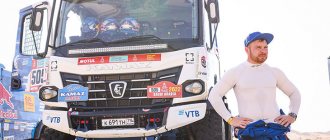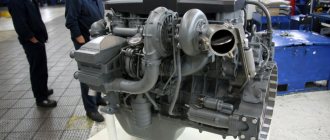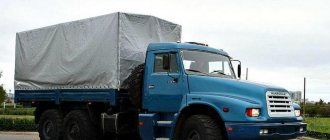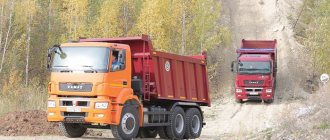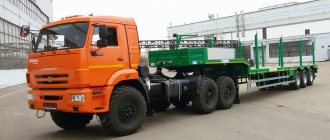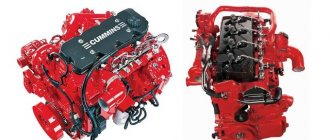KAMAZ was founded in 1969 as the Kama complex of factories for the production of heavy-duty vehicles (KAMAZ production association). This year, the Central Committee of the CPSU and the Council of Ministers of the USSR adopted a number of documents, including Resolution No. 674 of August 14, 1969 “On the construction of a complex of automobile factories in Naberezhnye Chelny of the Tatar Autonomous Soviet Socialist Republic.” The factories were to specialize in the production of heavy-duty vehicles only. The construction of factories in this place was facilitated by the location of the city - in the center of the country, the presence of the navigable rivers Kama and Volga, the proximity of the railway - which made it possible to provide the future auto giant with building materials, raw materials, equipment and components. According to the original project, it was supposed to produce 150 thousand heavy vehicles and 250 thousand engines per year.
The technical design of KamAZ was developed by the Giproavtoprom Institute and the KamAZ design department together with leading enterprises and organizations of the USSR: the Promstroyproekt Institute of the USSR State Construction Committee and Giprodvigatel (Yaroslavl). Also, foreigners were involved in the design of individual production facilities (Pittsburgh, USA) - technological and special parts of the foundry (France) - project (Stuttgart, Germany) - production of gearboxes. The design of the first generation of KAMAZ-5320 vehicles and engines is based on the promising family of ZIL-170 (6×4) and ZIL-175 (4×2) vehicles developed by the Moscow Automobile Plant named after. I.A. Likhachev and the Yaroslavl Motor Plant in 1967–1969.
More than 2,000 enterprises, all departments of the USSR State Supply Committee, ministries and departments fulfilled KAMAZ orders for construction materials and equipment. More than 100 thousand people worked at the construction site itself. The future automobile plant was provided with the most modern technological equipment at that time. More than 700 foreign companies took part in equipping it, including the world-famous corporations Swindell-Dresler, Holcroft, Seacast, Ingersoll Rand from America, Bush, Hüller, Liebherr from Germany, Italian Morando, Excella, Fata, French Renault, Swedish Sandvik, Japanese Kamatsu and Hitachi. KAMAZ was born literally out of nowhere - in the middle of a hilly field. To smooth out the uneven terrain and perform a vertical level, the builders had to fill and transport millions of cubic meters of soil.
In 1974, the first engine was assembled in the experimental workshop. A year later, the assembly of power units began using temporary technology.
From the chronicle of KAMAZ construction
| December 13, 1969 | The first bucket of soil was removed during the construction of the Kama Automobile Plant. |
| Autumn 1970 | The first cubic meters of concrete were laid in the foundation of the first-born KAMAZ - a repair and tool plant, as well as the building of a gray and ductile iron foundry. |
| January 1971 | The first 12-storey residential building in Naberezhnye Chelny was commissioned for KAMAZ pioneers. |
| 1973 | The buildings of almost all the facilities of the first stage of the complex were erected, the first city tram was launched, and the first power unit of the thermal power plant was put under load. |
| May 1974 | The first engine was assembled in the experimental control workshop of the chief designer of KAMAZ. |
| 1975 | At all factories of the complex, installation, commissioning of technological equipment and production of trial products are underway. |
| December 1975 | The first power unit was assembled at the engine plant - using temporary technology, but using its own resources. |
| February 16, 1976 | The first Kama truck rolled off the main assembly line of the automobile plant. The government of the country has approved a general scheme for managing the automotive industry. According to this scheme, KAMAZ received the status of a production association and began to report directly to the USSR Ministry of Automotive Industry, bypassing all central departments. |
| December 29, 1976 | The State Commission headed by the Minister of Automotive Industry of the USSR V.N. Polyakov signed an act on the commissioning of the first stage of the Kama complex of factories for the production of heavy trucks. Already by the time the first stage was put into operation, KAMAZ had huge production assets. They were 2 times higher than at VAZ and 3 times higher than the industry-wide figure for the Ministry of Automotive Industry. |
| October 1977 | KAMAZ completed its first annual plan ahead of schedule, producing 15,000 vehicles. By the end of December there were already 22 thousand. |
| August 1978 | The 50,000th truck has been manufactured. |
| June 1979 | Truck number 100000 rolled off the main assembly line. |
| April 1980 | The 150,000th heavy-duty truck was produced. The growth rate of production at KAMAZ was a record not only for our country. |
| February 1981 | The capacities of the second stage of KAMAZ were put into operation. |
Appearance
KamAZ 55111 is a dump truck with a simple and uncomplicated exterior. The rectangular colored cabin, which was mainly painted in an orange tint, is equipped with a wide and strong bumper, an air intake system and square or round optical instruments located on the sides.
55111 KamAZ has a welded bucket platform inclined towards the front side. The visor covers the space formed between the cab and the tractor body.
From the further history of the enterprise
| February 1983 | The main event of this year was the creation of a production facility, the main task of which was to provide all KamAZ vehicles with warranty service and supply spare parts for them for the entire life of the vehicle. By the end of the decade, it included 210 auto centers. A developed network of auto centers throughout the vast territory of the USSR, as well as abroad, immediately brought KAMAZ closer to the consumer, made it possible to quickly respond to customer requirements, effectively conduct marketing research, and carry out vehicle repairs and supply of spare parts as quickly as possible. Currently, KAMAZ auto centers are also turning into actively operating dealership centers for the sale of cars and spare parts. |
| 1986 | KAMAZ vehicles, which then made up a quarter of the country's truck fleet engaged in harvesting, transported 60 percent of the 1986 harvest. |
| 1987 | The production of minicars "Oka" was created. On December 21 of the same year, the first Kama minicar “Oka-VAZ-1111” rolled off the assembly line. In 1994, the Oka minicar plant was put into operation, designed to produce 75,000 cars per year. In 2005, ZMA became part of the Severstal-Auto group. |
| 1988 | According to experts, since the start of production of KAMAZ vehicles, the country has received about 8 billion rubles from their operation. transport profit. Thus, already in the first ten years of operation, KAMAZ fully justified all state investments associated with its construction. |
| June 25, 1990 | The government decided to create the KAMAZ joint-stock company on the basis of the property of the production association. KAMAZ became the first of the country's largest enterprises to enter the era of new economic relations. The charter of the KAMAZ joint stock company was approved at the general meeting on August 11, 1990, and the Company was registered on August 23 of the same year. |
| April 14, 1993 | A fire broke out at the engine plant, which in a matter of minutes engulfed the entire enterprise, almost completely destroying not only the production building itself, but also the most complex technological equipment. From the very first days of eliminating the consequences of the fire, work went in two directions - restoring the capacity to produce 100 thousand engines and, in parallel, creating the production of power units based on the latest technological equipment. In an unprecedentedly short time, thanks to the support of the government of Russia and Tatarstan, KAMAZ workers managed to literally restore the enterprise from the ashes. Already in December 1993, the engine plant produced its first products after the fire. |
| In January 2008 | The 1.9 millionth heavy truck was produced. |
| In December 2008 | The German concern Daimler AG acquired 10% of the authorized capital of KAMAZ OJSC. In 2010, Daimler increased its stake in the Russian truck manufacturer to 11 percent. At the same time as Daimler, four percent of KAMAZ securities were purchased by the European Bank for Reconstruction and Development. |
Description of the cabin interior
The KamAZ 55111 cabin was manufactured from solid metal. Two people can easily fit inside – a driver and a passenger. The cabin itself is located above the power unit and is equipped with a high roof. The developers managed to qualitatively protect it from the penetration of cold air and guarantee an acceptable level of sound insulation.
Please note that there is no place for rest and sleep in the cabin.
To decorate the interior of KamAZ 55 111, simple but strong materials were used. The seats are quite comfortable and high.
Advantages and disadvantages
Most drivers evaluate the KamAZ 55111 tractor positively. They loved it for the following advantages:
- Maintainability. The design is simple, so malfunctions are rarely observed. Spare parts are inexpensive.
- Suitable for use in off-road conditions. The car is designed in such a way that it can cope with many off-road conditions.
- Reliability and durability of main components. The main systems and elements are wear-resistant and rarely break down.
One of the main disadvantages of the model is its not entirely successful ergonomics. It is uncomfortable to stay in the cabin for a long time. The tractor also had some problems with its pneumatic system. The car itself is no longer produced.
Author: TECHNOmagazine
Share
Design
The layout of the KamAZ-5320 vehicle corresponded to the classic cabover design of trucks of that time. The cabin had three seats and tilted forward using a torsion bar, providing access to the engine. The power plant and gearbox are attached to the frame using shock-absorbing supports, thereby forming a single chassis complex.
Frame
The KamAZ-5320 frame is a load-bearing spar type with riveted joints. It consists of two parallel beams-spars connected to each other by seven transverse beams.
Carbon steel is used as the material for manufacturing the structural components.
The front parts of the load-bearing side members have a beveled structure for mounting the suspension. Towing hooks are also attached to them. The front buffer is mounted to the supporting beams using bolts.
Engine
The truck was equipped with V-shaped four-stroke diesel engines. The production of power plants was carried out by the Yaroslavl Motor Plant. The unit had a power of 210 and 180 hp at a maximum of 2600 rpm.
At that time, this type of engine was considered advanced, since its design used new technologies, including a nitrided crankshaft and full-flow oil purification in a centrifugal filter. The cooling system was equipped with a fluid coupling, which turned on automatically, regulating the operating temperature of the fluid.
Transmission
The KamAZ-5320 gearbox has a double-disc clutch. The clutch drive is controlled using hydraulics with pneumatic booster, which greatly facilitates the use of the pedal. A special feature of the gearbox is a divider (multiplier), which is an additional gearbox in front of the main gearbox.
Thus, five overdrive gears are added to the five direct gears.
Gear shifting occurs remotely using a rocker. The connection between the gearbox and the main drive units (axle) is carried out using cardan shafts and joints with needle bearings (crosspieces). The middle axle is equipped with a center differential.
Brake system
The KamAZ-5320 device uses a dual-circuit brake system for the front axle and rear bogie. It is divided into three subsystems: main, parking and spare. All wheels are equipped with brake drums. Each of them contains a pair of pads.
The brakes are powered by compressed air pumped by the compressor. The air is accumulated in receivers. When parking, the car is set to the parking brake, which operates using energy accumulators. They are located on the axles of the rear bogie.
Steering
The steering mechanism consists of: a steering wheel, a steering column, a driveshaft, a steering mechanism with a piston-rack, a bipod, steering rods and a hydraulic booster. The latter makes it easier for the driver to rotate the steering wheel, making control comfortable.
Suspension
The front suspension consists of springs and double-acting hydraulic shock absorbers. The rear suspension is of the balancing type. Rear spring leaves with sliding front and rear ends with T-profile.
Specifications
KamAZ had and remains its main competitor in the domestic market - the MAZ car. It is worth noting that the first developments of the ZIL-170 were carried out with the participation of specialists from the Minsk Automobile Plant. Each of the trucks has its own advantages and disadvantages, but there are still a sufficient number of admirers of both cars.
Here are the main technical characteristics for comparison:
| KamAZ - 5320 | MAZ-5335 | |
| Length, mm | 8395 | 7250 |
| Width, mm | 2500 | 2500 |
| Height, mm | 2830 | 2720 |
| Vehicle weight, kg | 7080 | 6725 |
| Load capacity, kg | 8000 | 8225 |
| Maximum speed, km/h | 80-85 | 80-85 |
| Fuel consumption, l/100 km | 23-29 | 22-24 |
| Engine power, l. With. | 210 (KAMAZ-740.10) | 180 (YaMZ-236) |
| Fuel capacity, l | 170 | 200 |
| Cabin type | No sleeping place | There is a sleeping place |
| Tires | 260 R 508 | 300 R 508 |


